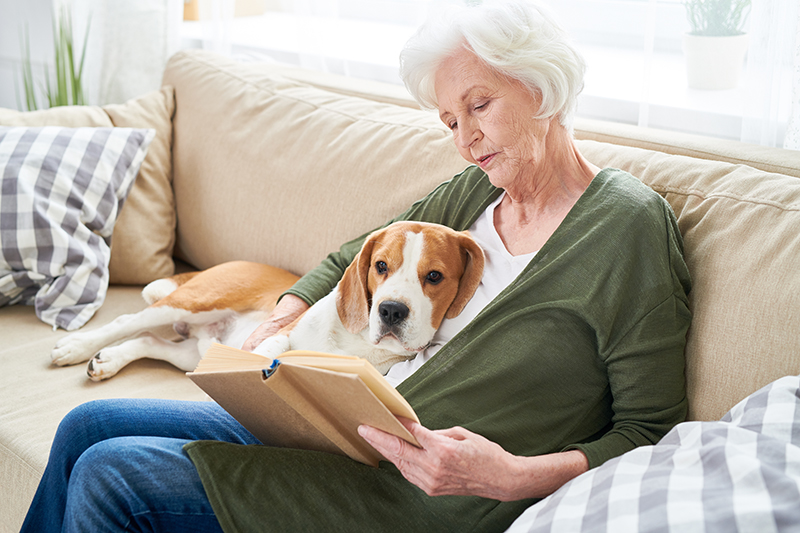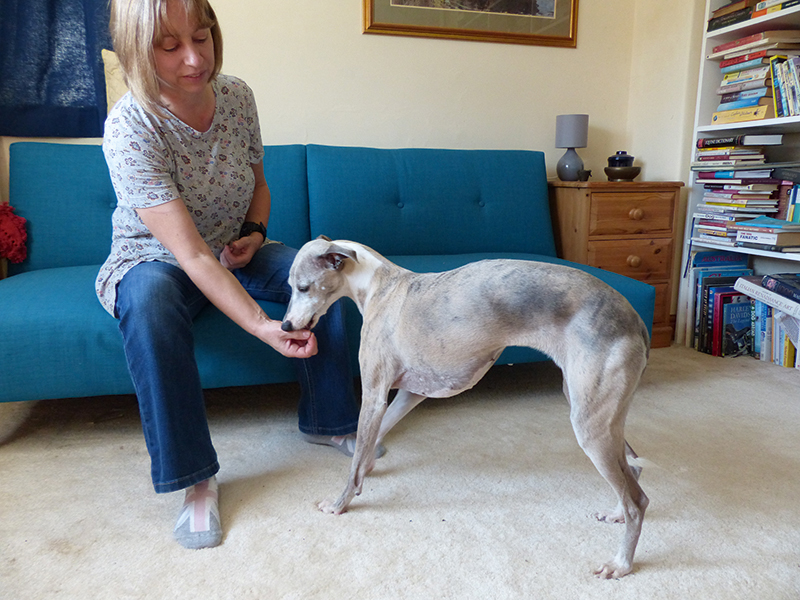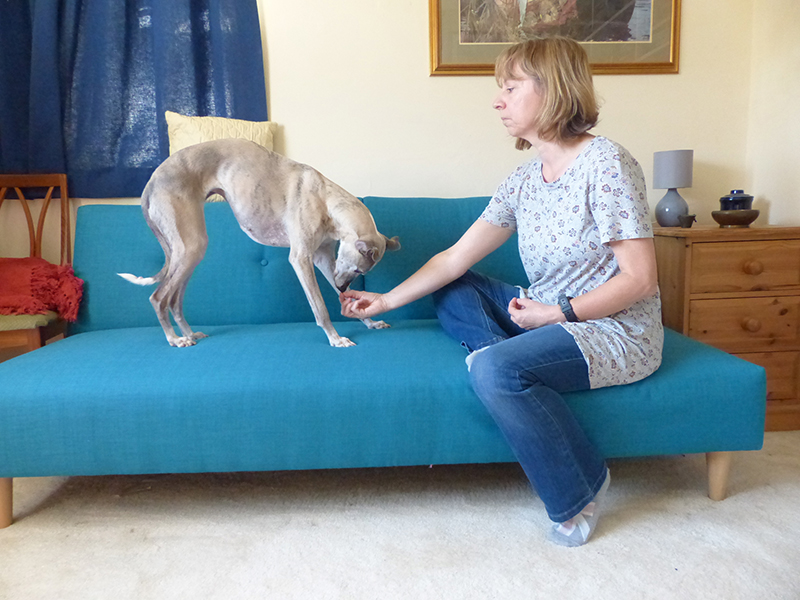You can still work your dog’s brain and keep their training up to scratch from the comfort of your own home.
Contents:
Start by having a treat pouch or pot close to hand so you can stay in the comfort of your armchair. Break treats into smaller pieces if necessary so you don’t fill your dog up too fast and remember to adjust his meal sizes if doing lots of training sessions.
● Choose soft, healthy treats that can be eaten quickly and don’t need a lot of chewing.
● If your dog does something really well, give a ‘jackpot’ reward of three, four, or five treats one after the other in quick succession.
● Lots of mini sessions with breaks in between is the way to success! Ask for around 10 repetitions during each training session so you don’t overdo things, or do three-minute sessions at a time.
● As well as having fewer distractions indoors, when you’re sitting comfortably you may be more likely to be extra-patient and less likely to rush your dog, so training sessions can be more successful. Once behaviours are solidly established indoors you can then transfer them to outdoor locations. Remember to repeat all the early steps of each task each time you move location.
TOP TIP!
Once your dog has learned the training basics, it’s easy to let things slide and get sloppy, so this can be the perfect opportunity to get your dog back up to scratch. Even if your dog is pretty good, you can still work on improving speed of response and duration.
TOP TIP!
Once your dog understands the cue, move it to different places — maybe a log or bench when out on a walk.
UP!
Most dogs don’t need a lot of encouragement to hop up onto the sofa next to you — so why not teach it as a proper cue? This will come in handy not just when you want a cuddle, but on those occasions when you want him to jump up onto something else, such as getting in the car.
1. Have your treats ready and pat the sofa beside you. As your dog jumps onto it say ‘Up, up’ and feed him. If he needs encouragement try throwing the treat onto the sofa or luring him up.
2. Give him a cuddle and lots of praise and let him settle down for a comfy sleep — or move onto the next task, teaching him to get off the sofa on cue.
OFF!
Having taught your dog a cue to hop up on the sofa, it’s a good idea to teach him an ‘Off’ cue too; this can also come in handy in other situations such as when teaching him to keep off garden flower beds.
Your armchair is also a great place to catch up on some reading!
FETCH
Some dogs seem baffled when asked to return items thrown for them — but sitting in your chair can be the perfect place and time to teach your pet that a game of fetch can be fun.
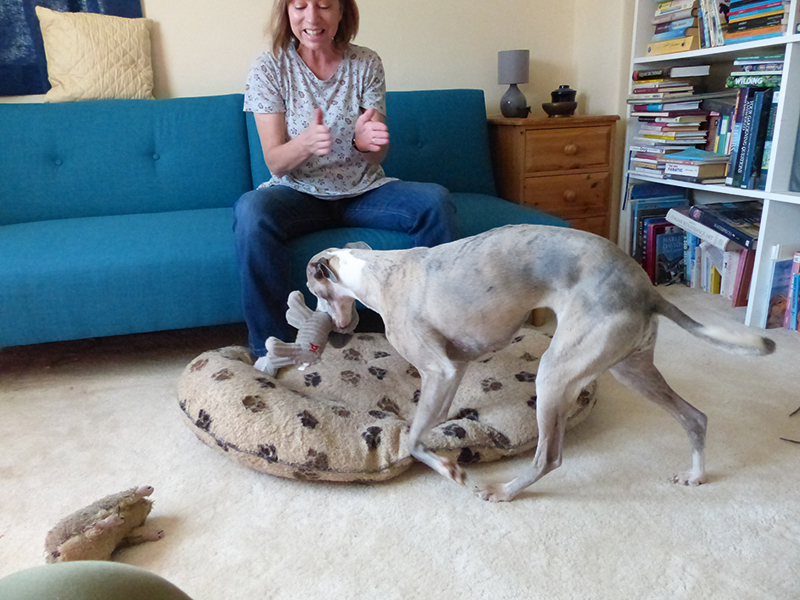
● If your dog isn’t interested in chasing toys, try motivating him by using one that can have food inserted inside it, such as a Kong Ballistic Hide ’n Treat toy.
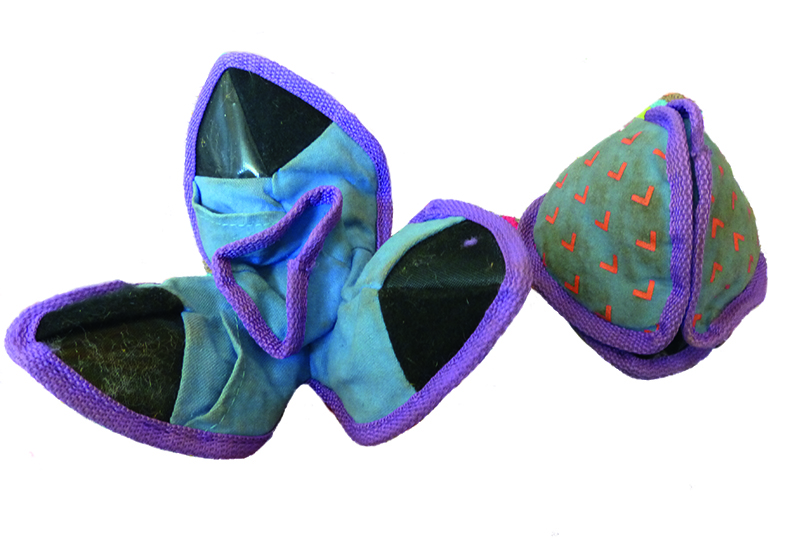
1. Place a comfy bed or mat at your feet and find a toy your dog loves. Start to move the toy around to excite him and gain his interest.
2. Throw the toy a short distance away from you and as your dog picks it up, make excited noises or gently clap your hands together. You are inviting your dog to return to you; the bed at your feet makes it a nice place to return to.
3. Once your dog has come close to you, use lots of verbal and physical praise to tell him what a good dog he is, and wait for him to drop the toy.
4. Once he drops it, immediately throw it again and repeat.
5. When he’s consistently returning to you with the toy, start to add in the ‘Fetch’ cue.
DROP
Many dogs find it challenging to give an item up; teach yours it can be rewarding!
1. Start your training session by having a game of tug with your dog.
2. Keeping it as still as possible, hold the toy with one hand while offering your dog a tasty treat held just in front of his nose.
3. As he releases the toy, say the cue word ‘Drop’ and give him the treat.
4. Give a verbal cue such as ‘Take it’ to tell him he can take the toy and restart the game.
If your dog isn’t food motivated or can be possessive of toys:
1. Have two identical tug toys. Invite your dog to have a brief game of tug with one.
2. When you want him to give the toy back, keep the toy as still as possible so it becomes less interesting, while simultaneously waving the other one around excitedly.
3. As your dog releases the now boring first toy, say ‘Drop’ and immediately throw the other toy for him to go fetch.
4. On his return have another game of tug before repeating.
5. Test it out: can you say ‘Drop’ and he immediately surrenders the toy? If not, go back to step 1.
FIND IT!
Dogs who aren’t very excited by games of fetch may find this foodie variation more appealing — and while your dog’s having fun, you can also be booting up your recall.
1. Let your dog see you have a treat in your hand, then toss it a short distance away. Tell him to ‘Find it’ and let him hunt it down using his nose as well as his eyes.
2. Your dog will quickly learn that returning to you each time generates another thrown treat and you can start to introduce a recall cue as he moves towards you.

The ‘Find it’ game can also help to improve your dog’s recall.
CLICKER TRAINING
Your armchair is the perfect place from which to introduce clicker training; fun and highly rewarding, it encourages your dog to really engage his brain.
A clicker is a small plastic box with a button, which when pressed makes a distinctive clicking noise. After teaching your dog to associate the sound with a treat, you can then use it to let your dog know when he’s done the right thing. Because you can mark the precise moment, your dog is less likely to be confused about what he’s being rewarded for; it can make training at a distance (from your armchair for example!) easier and more successful and also allows you to ‘shape’ more complicated actions, by breaking them into lots of small, easier steps. If you prefer, or have a noise-sensitive dog, use a click of your tongue or a voice marker such as ‘Yes’ instead.

Once your dog has mastered individual actions, try pairing them — such as asking him to retrieve a toy and drop it in his toy box.
1. Click or use your voice marker, and immediately feed your dog a small tasty treat.
2. Repeat until you can see your dog is anticipating getting a treat each time he hears the click.
3. You can now use the clicker/voice marker while teaching your dog. Start with something simple, such as asking for a ‘Sit’. Lure him into position using a toy or treat moved just in front and slightly above his nose. The moment his bottom touches the floor, click (or use a voice marker) and then reward.
● Your armchair is also a great place to catch up on reading — find out more about clicker training in ‘Clicker Training for Dogs’ by Karen Pryor (Sunshine Books).
ARMCHAIR TRAINING - PART 2

At this time of year, an armchair by the fire may seem more inviting than a trip outdoors! And there are alternatives when it comes to your dog’s training, as Toni Shelbourne and Karen Bush explain.
There is no need to feel guilty if both you and your dog would prefer to stay indoors. That cosy armchair can actually be the perfect place from which to brush up on training and maybe add a few new skills to your dog’s repertoire.
Following on from last month, here are some more ideas for you to try!
TOP TIPS!
Keep sessions short and sweet; repeat frequently with lots of breaks in between rather than having one long session.
Have a treat pouch or pot close to hand, containing a selection of tasty treats that are quick and easy to eat.
Mark the action! Using a clicker, verbal word, or click of your tongue can be a good way of letting your dog know when he’s done the right thing. It lets you mark the precise action you’d like him to repeat, so he’s less likely to be confused about what he’s being rewarded for. Follow it up with the expected treat, plus plenty of praise.
TOUCH!
Target stick training is fun, easy to teach, and gives you a longer reach when training from your chair so you can work at a short distance from your dog. The idea is that you teach your dog to touch the end of the target stick with his nose first, and then to follow it as you move it. Extending, telescopic target sticks are ideal as you can adjust the length, but if you don’t have one, improvise with a piece of dowel or a wooden spoon.
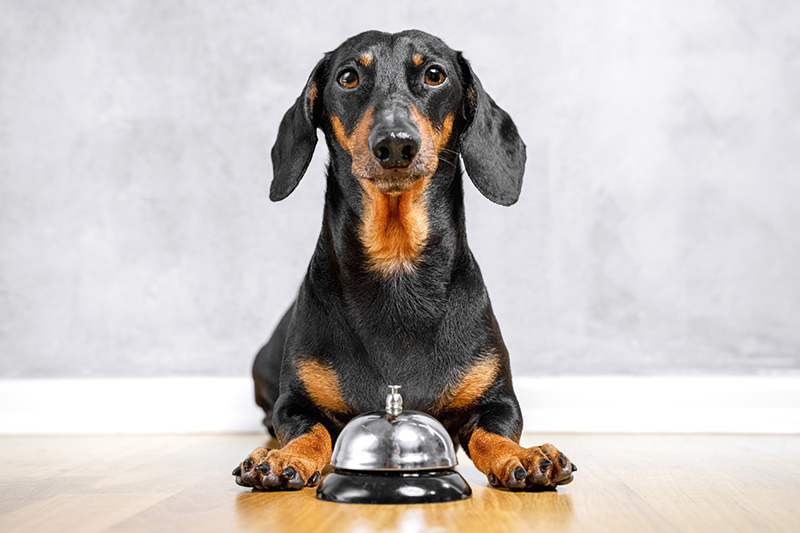
You can transfer the ‘Touch’ cue to other items, such as ringing a bell.
1. Hold the target stick so the end is 5 – 10cm in front and slightly to the side of your dog’s nose. If he’s curious and touches it immediately, mark and reward with a treat.
2. Not interested? Encourage him by rubbing a treat on it so it smells good; the instant he touches it, mark the moment and reward with a treat. Don’t allow him to lick or chew the stick!
3. Repeat until your dog understands that nudging the end of the stick gains a reward. Now, move the tip of the stick a little to the right, or left, or a little higher or lower than his nose, keeping it within easy touching distance. If he loses interest, move it out of view for a few seconds, before showing it again to regain his attention.
4. When he touches the stick every time, add a verbal cue ‘Touch!’ just before presenting it, rewarding as usual when
he does.
5. Progress to moving the stick a little distance away so he has to reach further to touch it. Build on this until your dog takes first one, then several, steps to reach it.
● A target stick has many practical applications, such as targeting your dog into the car, off the sofa, or onto the scales at the vet’s.
● Once learned, you can transfer the action to other items, asking your dog to ‘Touch’ and rewarding him when he does. You can then use the skill to teach him to do things such as shut doors, ring a doggy doorbell, or to improve heel work.
Hold the target stick 5 – 10cm in front and slightly to the side of your dog’s nose.

Progress to moving the stick a little further away so your dog has to reach further to touch it.

A target stick has many practical applications, such as targeting your dog into the car, off the sofa, or onto the scales at the vet’s.
CHIN REST
Veterinary appointments will be less scary for your dog if you don’t have to pin him down to be examined, but can ask him to quietly stand still. Teaching this exercise will help, and can also make it easier for you to groom him, or administer treatments such as spot-ons, or ear drops.
1. Depending on the size of your dog, place a folded towel on the arm of your chair, your lap, or a low stool next to you, with the open end of the fold facing away from your dog. Place a treat in the fold. If your dog touches the towel with his nose or chin, mark the action and give a treat from your hand.
2. Next, encourage your dog to rest his chin firmly on the towel; he may do it of his own accord, but if not, lure his head into position using a treat. When he does this, give a jackpot reward of 5 – 10 treats fed one after the other in rapid succession while he’s still in the desired position, so he learns it’s an action worth repeating.
3. Begin asking for longer chin rests, by building in a continuation cue such as ‘Hold’. Do this by feeding him while in position, and gradually slowing the delivery of treats until eventually you can just say ‘Hold’ without the aid of food. Teach a release cue too, by saying a word such as ‘OK’ and tossing a treat away from you.
4. Once you are reliably getting a good quality chin rest, add in a cue word such as ‘Rest’. Pair it with a hand action; usually the same movement you made to lure his head into position. Remember to reward the chin rest with a treat from the other hand.
5. Eventually you’ll be able to ask him to rest his chin, maintain it without feeding, and then give him the release cue, at which point you treat him. Work up to this slowly. The towel makes it easy for you to now transfer the chin rest to different surfaces and in different places.
● Once learned, you can progress to your dog resting his chin on your hand. This creates a useful two-way conversation during a veterinary examination or when giving treatment; if your dog breaks the chin rest by moving his head, you’ll know he needs a break.
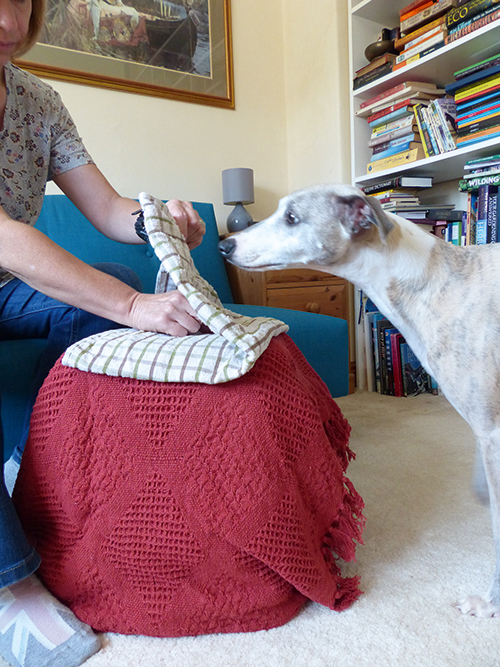
Place a treat in the fold of a towel laid on the arm of your chair or a low stool.

If your dog touches the towel with his nose or chin, mark the action and give a treat from your hand.

Next, encourage your dog to rest his chin firmly on the towel, using a treat to lure him into position.
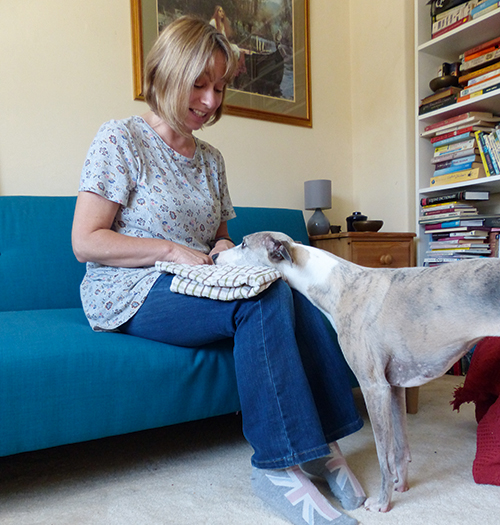
Using a towel will make it easy for you to transfer the chin rest to different surfaces and places.
WALK BACK
Teaching your dog to walk backwards can improve his body awareness and co-ordination, as well as being useful if he gets stuck in a tight spot he can’t turn round in, and needs to reverse.
1. Hold a treat near your dog’s chest so he looks down and shifts his weight, and eventually his feet, backwards so he can see it. Mark and treat.
2. At first it may only be one step, but as he gets the idea, build up over multiple sessions to asking for more. At this point you will need to leave your armchair so you can walk with him to encourage him to take more steps.
3. Once he’s consistently walking several steps backwards, add the cue word ‘Back’, and over time fade out the treat to lure him, but keep the hand movement.
4. When you can cue him with word and hand movement, try standing still so he reverses away from you; when he’s mastered this, you can try it from your armchair!
Begin by holding a treat near your dog’s chest so he looks down and shifts his weight — and eventually his feet — backwards so he can see it.
BOW
Another fun trick to impress your friends, this one will also stretch out your pet’s back, and can help him communicate better with other dogs. Teach a bow and watch him offer it more often towards other dogs he wants to play with.
1. Place a treat on your dog’s nose, then slowly move it downwards and slightly inwards toward his chest. As his elbows start to dip slightly, mark and treat.
2. Repeat, rewarding the elbow dip as it becomes lower and lower; this may take a few sessions.
3. Eventually your dog will lower the whole front half of his body to the ground, leaving his bottom in the air. Be ready to rapidly feed him in this position to get him to hold the bow. If he looks like he’s going to lie down instead, throw a treat to the side to get him to move, and start again.
4. Once consistently offering the posture, name it ‘Bow’, and start slowing down, then fading the treats until you can just give him one treat as you release him with an ‘OK’ cue.
Place a treat on your dog’s nose, then slowly move it downwards and slightly inwards toward his chest. As his elbows start to dip slightly, mark and treat.

Repeat, rewarding the elbow dip as it becomes lower and lower.
SPIN
Teaching a few tricks can be fun for both of you; this simple one also helps improve your dog’s flexibility.
1. Use a target stick or a treat held between your fingers to lure your dog round in a circle.
2. Ask for just a step or two in the right direction to begin with, gradually building up over several sessions to completing a whole circle.
3. You may notice your dog finds it harder to turn in one direction than the other; this may just be general one-sidedness but keep an eye on it. If it persists or becomes worse, ask your vet to give him a check over.
4. Once he consistently circles, remove the treat from your hand (or the smell from the stick) but make the same movement, rewarding him at the end of the spin.
5. When he can do this, add in the verbal cue ‘Spin’.
6. Gradually you’ll be able to reduce your hand movement to a tiny circle of your finger (or the stick) in front of your body and your dog will spin in front of you.
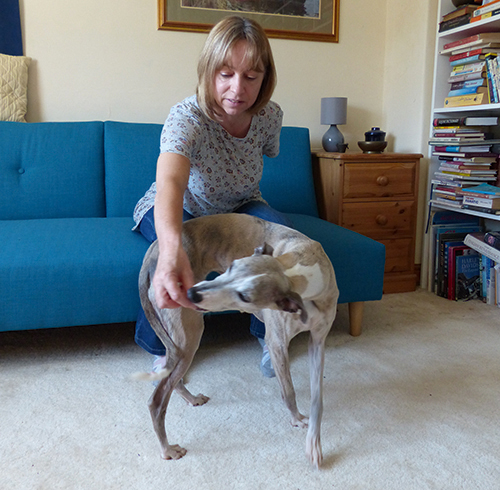
Use a treat or target stick to lure your dog round in a circle.
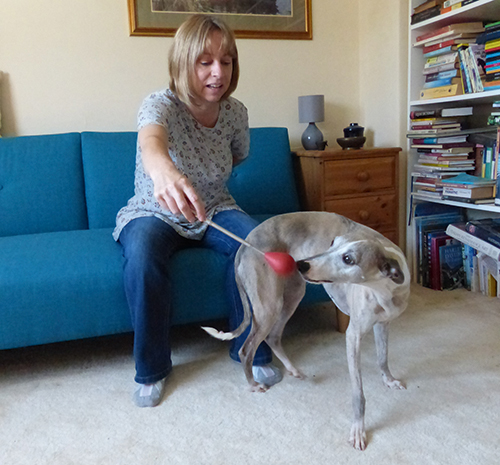
● Using a clicker to mark when your dog gets it right? Find out more about clicker training in ‘Clicker Training for Dogs’ by Karen Pryor (Sunshine Books).










